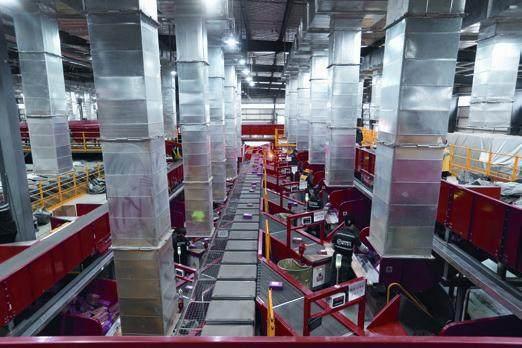SINGLES’DAY SHOPPING SPREE

A smart organizing system sorts packages at a distribution center in Qingdao, Shandong Province, on November 7, ahead of the Singles Day shopping festival on November 11. The festival marks an annual shopping bonanza across the nation. Known as Double Eleven, it was first launched by e-commerce giant Alibaba on its Taobao platform on November 11, 2009.

Heavy Snow
A snowplow clears a road in Shenyang, Liaoning Province, on November 9. A blizzard starting from November 7 brought record snowfall, the biggest since 1905, to Shenyang, local meteorological authorities said on November 9. As of 8 a.m. on November 9, the average snowfall in the city reached 51 mm.
Wetland Conservation
China will host the 14th Meeting of the Conference of the Contracting Parties to the Ramsar Convention on Wetlands (COP14) from November 21 to 29 in 2022 in Wuhan, capital of Hubei Province, the National Forestry and Grassland Administration(NFGA) announced on November 8.
It is the first time China will host such a meeting, the administration said.
The Ramsar Convention on Wetlands, also known as the Convention on Wetlands, is an intergovernmental treaty that provides the framework for national action and international cooperation for the conservation and wise use of wetlands and their resources. Thus far, it has gathered 172 contracting parties.
Since its accession to the treaty in 1992, China has adopted a series of measures aimed to protect the wetlands.
The country has so far designated 64 wetlands of international importance, 602 wetland nature reserves and 1,693 wetland parks, according to the NFGA.
Power Supply
The State Grid Corporation of China said on November 7 that the supply and demand of power in areas served by the company have returned to normal.
The thermal coal inventory in the companys operating area has rebounded to 99.32 million tons, while the available days of consumption have risen to 20, said the company.
The scale of power curbs and the electricity gap have been significantly reduced, it said, adding that, as of November 6, power supply to some factories with high energy consumption and high pollution in certain provinces was still being limited.
The grid will face an “overall tight balance of power with gaps in some areas” this winter and coming spring as the country faces a power-consumption peak plus the drought season for hydropower.
The company will strive to ensure the power supply for households, public services and key customers, said Meng Haijun, spokesperson with the State Grid.
The State Grid is the worlds largest utility company and ranked second among the Fortune Global 500 in 2021. It supplies power to a population of over 1.1 billion, with its service area covering 88 percent of Chinese territory.
Child Health
The National Health Commission on November 5 published a new action plan for improving child health during the period from 2021 to 2025. The plan addressed seven key areas, including newborn safety, birth defect prevention, healthcare and early childhood development services.
According to the plan, mortality rates among newborn babies, infants, and children under five will be kept below 3.1, 5.2, and 6.6 per 1,000, respectively, by 2025.
Over the next five years, more than half of infants under six months will be exclusively breastfed. The growth retardation rate among children under five will also be kept within 5 percent, read the action plan.
Eye and vision care and examination services for children under six will cover over 90 percent of the age group, it said. It underlined the early detection and treatment of child health risks such as anemia, obesity, autism and hearing impairment.
Crude Oil Wharf
Supertanker NEW WEALTH berthed at the 300,000-ton crude oil wharf at Qinzhou Port in Guangxi Zhuang Autonomous Region on the morning of November 5, marking the start of the wharfs trial operation.
With an investment of about 2.32 billion yuan ($362.6 million),the 300,000-ton crude oil wharf in the Beibu Gulf Port is a landmark project in the construction of the New International LandSea Trade Corridor, a trade and logistics passage jointly created by western Chinese provincial regions and Singapore, according to Hu Huaping, Deputy Director of the regional transportation department.
The new wharf has an annual throughput capacity of 9.86 million tons at the single side of the berth.
After the project goes into operation, it can greatly reduce the transportation cost of crude oil loading and unloading in the port, thereby improving the handling capacity of bulk liquid cargo and enhancing the ports core competitiveness, which is of great significance for better serving the development of the petrochemical industry in Guangxi.
Groundwater Regulation
A regulation on the management of groundwater, which will take effect on December 1, has set out specific rules for groundwater, reported Xinhua News Agency on November 9.
Local water administrations and natural resource and ecological environment authorities should conduct surveys and evaluations on groundwater conditions, and make underground protection and pollution control arrangements accordingly, it said.
To enhance groundwater conservation and protection, the total amount of groundwater extracted, as well as groundwater levels, will be placed under control, according to the document. Except under special circumstances, groundwater that is not replenished easily should not be exploited.
The regulation has also stipulated that the designation of areas where the exploitation of groundwater is prohibited or restricted should be standardized, and provincial-level authorities should make plans for local groundwater over-exploitation treatment.
Antarctic Expedition
Chinese researchers wave goodbye as the research icebreaker Xuelong, or Snow Dragon, sets off from Shanghai on November 5 for the 38th Antarctic expedition. A first batch of 154 researchers onboard the ship will return to China in mid-April 2022.

Cultural Relic Studies
The number of researchers specializing in cultural relics is expected to increase by 25 percent by 2025, according to a five-year plan for cultural relic protection and sci-tech innovation in relevant fields, which will soon be released.
Li Qun, Vice Minister of Culture and Tourism and head of the National Cultural Heritage Administration, elaborated on the document at a press conference in Beijing earlier this week.
China boasts 767,000 immovable cultural heritage sites and 108 million pieces (sets) of state-owned movable cultural relics. Despite its rich cultural heritage resources, statistics show that the country employs only 175,700 people in the industry.
To solve this issue, the document highlights the cultivation of more archaeological talent. Measures include expanding the enrollment of relevant majors in colleges and universities and setting up related majors across vocational education institutions, Li said.
The document further proposes to innovate talent employment and management in the field.
Safety Awareness
A firefighter introduces fire extinguishing equipment to primary school students in Urumqi, capital of Xinjiang Uygur Autonomous Region, on November 9, Chinas National Fire and Rescue Day.

Supporting Tool
The Peoples Bank of China(PBC), the central bank, said on November 8 that it had rolled out a supporting tool for carbon reduction as part of efforts to facilitate the countrys goal of carbon neutrality.
The PBC will provide low-cost loans for financial institutions through the mechanism, and will guide those institutions to provide loans to firms in key carbon-reduction fields on the premise of independent decision-making and risktaking, according to a statement released by the PBC.
The interest rates provided by the financial institutions should, in general, be in line with benchmark lending rates, or the loan prime rates, it said.
Financial institutions will be able to apply for the lowcost funding from the central bank after the loans for carbon reductions are made. The PBC will provide 60 percent of the loan principal, with a one-year lending rate of 1.75 percent.
Forex Reserves
Chinas foreign exchange reserves rose to $3.2176 trillion at the end of October, up $17 billion from a month earlier, official data showed on November 7.
The volume went up 0.53 percent from the end of September, the State Administration of Foreign Exchange (SAFE) said.
Wang Chunying, Deputy Director of SAFE, attributed the October increase to the combined impact of currency translation and changes in asset prices.
The dollar index fell slightly due to factors such as the resurgence of the COVID-19 pandemic and expectations for major economies fiscal and monetary policies, Wang said, adding that the currency translation and the change in asset prices led to the rise of Chinas foreign exchange reserves.
Market Entities
The number of market entities in China topped 150 million on the back of government efforts to streamline the process for starting a business, according to the State Administration for Market Regulation. Of the total, about 100 million emerged in the past 10 years.
The number of individual businesses exceeded 100 million.
Market entities established since 2013 paid 3.81 trillion yuan($596 billion) in taxes in the first three quarters of the year alone, nearing last years annual total, official data showed.
Tax, Fee Cuts
Chinas tax and fee cuts totaled more than 910 billion yuan ($142 billion) during the first three quarters of the year, according to data from the State Taxation Administration.
Some 788.9 billion yuan($123.4 billion) of taxes and 121.2 billion yuan ($18.9 billion) of fees were reduced, it said.
Since the beginning of this year, a mix of tax and fee cuts has been announced to alleviate financial burdens on businesses and strengthen market vitality, the administration added.
NEV Sales
Nationwide sales of new-energy passenger vehicles soared 141.1 percent year on year to 321,000 units in October, according to the China Passenger Car Association on November 8.
During the first 10 months of the year, sales of these cars skyrocketed 191.9 percent from a year earlier to 2.14 million units.
The market performance of new-energy cars and fossil fuel vehicles took diverging paths, with the former continuing to see explosive growth, Cui Dongshu, Secretary General of the association, said.
The countrys passenger car production declined 4.1 percent year on year in October while sales fell 13.9 percent from a year earlier, data from the association showed.
In 2022, Chinas wholesales of passenger cars will likely grow 5 percent, the association said.
Energy Consumption
China recorded a slower growth of energy consumption in the third quarter, the National Energy Administration said on November 8.
The year-on-year growth of energy consumption dropped 14.3 percentage points from the first quarter and 4.7 percentage points from the second, partly due to remarkable energy use drops in energy-intensive industries.
Of the total, coal consumption growth shrank 13.1 and 2.8 percentage points from the first and second quarter, respectively.
The clean energy sector has also been expanding. By the end of September, the installed capacity of hydro, nuclear, wind and solar power totaled 1.01 billion kW, accounting for 44.1 percent of the total installed capacity, up 3 percentage points from the same period last year.
Nuclear Reactor
Fuel loading at Chinas second nuclear power reactor using Hualong One technology, a domestically developed thirdgeneration reactor design, started on November 6 at the No.6 nuclear power reactor in the city of Fuqing in Fujian Province, bringing it one step closer to operation, according to the China National Nuclear Corp. (CNNC).
Boasting 716 national patents and 65 international ones, over 200 overseas trademarks, and 125 software copyrights, the Hualong One reactor has a design life of 60 years and meets the strictest safety standards in the world.
The first nuclear reactor using Hualong One, the No.5 reactor in Fuqing, began commercial operation in late January. To date, it has generated more than 7 billion kWh of electricity. So far, there are eight nuclear power reactors with Hualong One technology being built or in operation in the world, according to the CNNC.
Foreign Trade
Chinas foreign trade maintained growth momentum in the first 10 months of 2021 as the economy continued its stable development.
Total imports and exports expanded 22.2 percent year on year to 31.67 trillion yuan ($4.89 trillion), the General Administration of Customs of China (GACC) said on November 7.
The figure marked an increase of 23.4 percent from the pre-pandemic level in 2019, according to the GACC.
Both exports and imports continued double-digit growth in the period, surging 22.5 percent and 21.8 percent from a year earlier, respectively.
In October alone, the overall trade volume came in at 3.34 trillion yuan ($522.7 billion), up 17.8 percent year on year but down 5.6 percent month on month, the data showed.
In the January-October period, the growth rates of Chinas trade with its top three trading partners—the Association of Southeast Asian Nations, the EU and the U.S.—stood at 20.4 percent, 20.4 percent and 23.4 percent, respectively.
Its trade with countries along the Belt and Road routes rose 23 percent year on year during the same period, customs data showed.
Imports and exports by private enterprises saw an increase of 28.1 percent to 15.31 trillion yuan ($2.4 trillion) in the first 10 months, accounting for 48.3 percent of the countrys total. The volume of state-owned enterprises amounted to 4.84 trillion yuan ($757.4 billion), an increase of 25.6 percent.
Exports of mechanical and electrical products registered robust growth in the first 10 months. Exports of automobiles surged 111.1 percent.
NUMBERS



